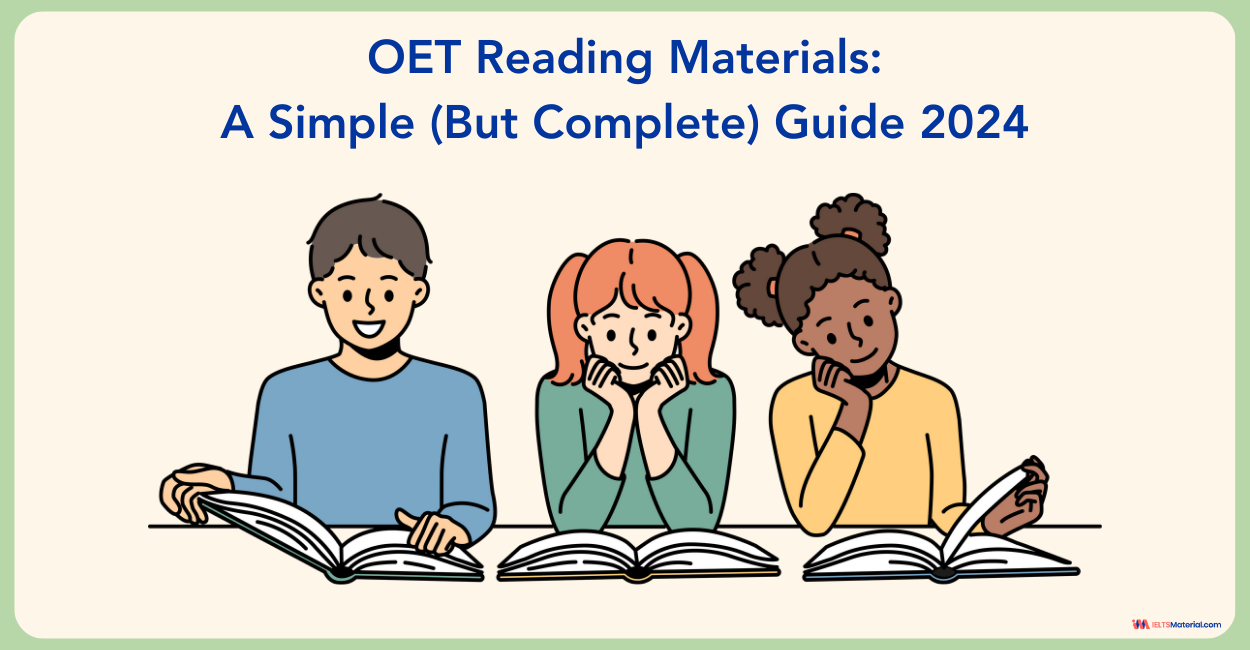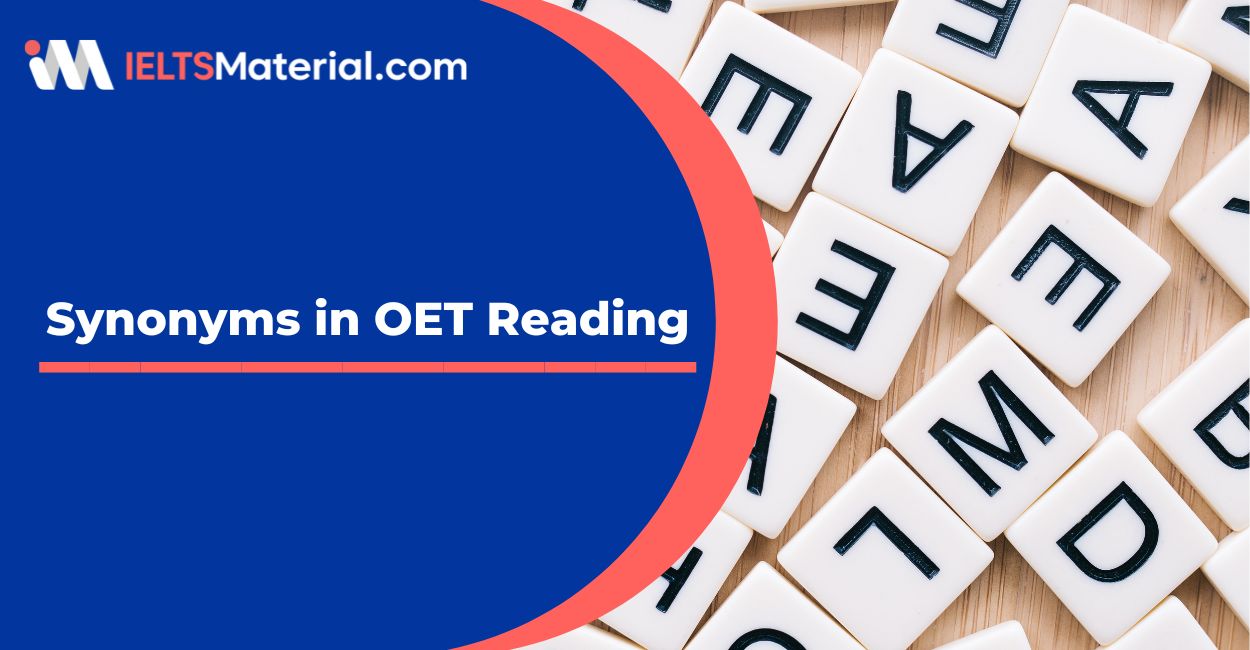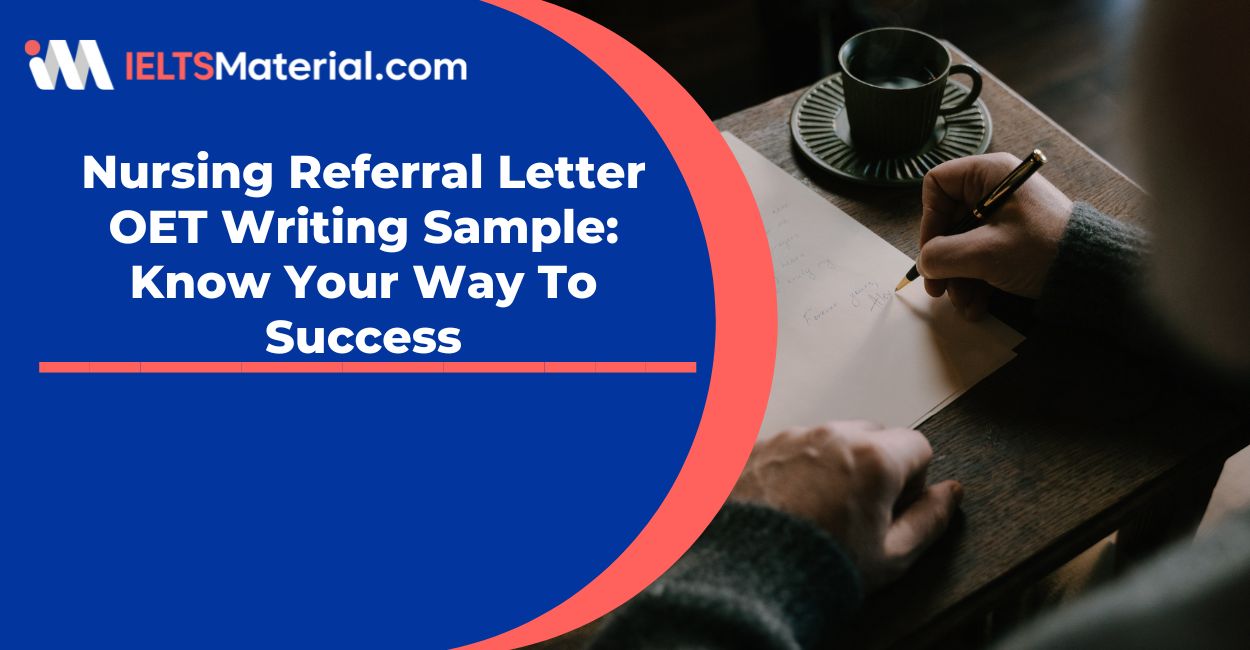Synonyms in OET Reading
5 min read
Updated On
-
Copy link
Table of Contents

Limited-Time Offer : Access a FREE 10-Day IELTS Study Plan!
Healthcare workers working in an English-speaking country have to use the language on a daily basis at work and so they must display fluency and skill in the language. In order to choose healthcare practitioners with the appropriate degree of English proficiency to provide safe and high-quality care, healthcare organisations and regulators turn to OET. Besides this, the OET is recognised as evidence of English language ability for visas, immigration, registration, and work in the healthcare sector.
As the OET is a test of English language proficiency rather than medical knowledge, test developers take care to limit instances in which candidates may reply using prior information rather than language abilities. Therefore, the OET Listening and Reading subtests are not industry specific.
These two subtests include a range of topics of general medical and health interest and are given to all candidates. The language activities and questions related to the texts are intended to assess language knowledge and ability rather than the candidate’s understanding of the field, even though some themes may contain content that is recognisable to one particular health practitioner’s area of experience and skill. As a result, improving vocabulary by learning new words and their synonyms is a must for OET Reading and Listening subtests.
In this article, we will take a look at the Reading Subtest and how to gain a good score.
Reading Overview
The Reading Subtest has three parts: Parts A, B, and C.
It has 42 questions in all – of which, Part A contains twenty questions, Part B includes six questions, and Part C has sixteen questions. You will have 1 hour to complete the Reading Subtest. Part A will take 15 minutes to finish, and Parts B and C together will take around 45 minutes.
Questions in Part A require concise and brief written responses. Your ability to quickly and effectively locate and repeat specific information is tested in Part A. You have 20 minutes to complete the 20 questions about the four short readings, all of which are about a single aspect of healthcare. Matching, sentence completion, and short answer questions make up the 20 questions. Whereas in Parts B and C, there are just objective question types. Your ability to understand the specifics, essence, or main idea, as well as discern precise meaning and viewpoint, will be evaluated.
The materials may include excerpts from manuals, hospital policies, manuals, or internal correspondence, like emails or memos. Each question is worth one mark. For an overall score of 350+ in the Reading Subtest, you will need to get at least 30 out of 42 questions correct. There is no negative marking.
Importance of Synonyms in expanding vocabulary
Building up your vocabulary, especially synonyms, is one of the most beneficial things you can do to enhance your performance on the Reading Subtest.
Synonyms are significant because they serve to improve writing quality and offer readers a clear and distinct view of the content. It can also help with both spoken and written communication abilities. A thorough understanding of word meaning is required for accurate word selection. In grammatical terms, ‘meaning’ also implies factors such as a word’s formality, the words it combines with, i.e. collocations, its various meanings, and its contexts of use.
The choice of synonyms is a crucial component of creating appealing written materials. The following are some of the advantages of employing synonyms:
- Text becomes more appealing.
- Avoids monotony in speech and writing; improves communication with people
- Aids readers in better visualising
You’ll find it simpler to recognise and comprehend what you read if you know how to do this. As a result, you’ll also be better able to respond to inquiries about the test’s texts and passage extracts.
Tips to expand reading vocabulary
By regularly using our expert study strategies and tips, you can improve your OET Reading skills:
- Browse an open-access medical journal. Pick an article you find intriguing. As you read the article, underline any new words and try to figure out what they imply. Return to the words you underlined at the end of the article and look them up in a dictionary.
- Build word families. A word family is a collection of words that share a common root and can be used to produce numerous new words with related meanings. Thus, developing your awareness of word families can be a very effective and useful strategy to improve your comprehension of English literature in general. Additionally, it will deepen and broaden your comprehension of particular words. Examples:
- happy, unhappy and happiness
- infection, infectious and infect
- Play, player, playfulness, etc.
- Comprehend new words. You must be able to understand new vocabulary because it is crucial to understanding a text. While attempting to understand the meaning of a word or phrase that is unknown, you should try to connect it to the larger sentence as your first step. Trying to ascertain its function is one technique to do this. For instance, is it acting as a subject or an object? Or may it be an adjective or verb?
- Interpret Keywords. We may interpret words and phrases extremely differently if we misinterpret whether they are positive or negative. You’ll get further if you grasp negation and learn the antonyms of common words as well.
- Negation in grammar: When a particular kind of word called a negative is added, certain words or entire sentences are nullified or revealed to be untrue. Examples:
– She’s never been to India.
– There were no books left in the shop.
– None of my friends live near us.
- Antonyms: An antonym of a word is a word with the opposite meaning.
Examples:
- hot/cold
- good/bad
- happy/sad
- Locate the connectors. Connectors are words or phrases that help the reader understand how one sentence or clause relates to another. We can determine a phrase’s relationship to a preceding or subsequent phrase if we can locate a connector close to our unidentified phrase. The word “But” serves as a connector at the start of the phrase in the example below. This indicates that the following information will contradict a perception.
Example: She’s 40 years old, but she looks much younger.
You probably won’t worry too much about medical terminology if you’re getting ready to take the OET. You are a medical expert, after all, and you are well-versed in this information. But what about idioms, phrasal verbs, and other uncommon terms that might appear? You must learn to deal with new terms or expressions as they emerge. Through diligent everyday practice, you are sure to have new vocabulary under your belt every day!
Exercise
Choose the correct answer.
- Big and small are:
- Antonyms.
- Synonyms.
- Black and white are
- Antonyms.
- Synonyms.
- Fantastic and wonderful are
- Antonyms.
- Synonyms.
- Expensive and costly are
- Antonyms.
- Synonyms.
- Terrific and terrible are
- Antonyms.
- Synonyms.
Answers
- Antonyms
- Antonyms
- Synonyms.
- Synonyms.
- Antonyms
Check More IELTS Reading Answers
Other OET Exam Related Articles

Start Preparing for IELTS: Get Your 10-Day Study Plan Today!
Recent Articles

Kasturika Samanta

Haniya Yashfeen

Kasturika Samanta





Post your Comments